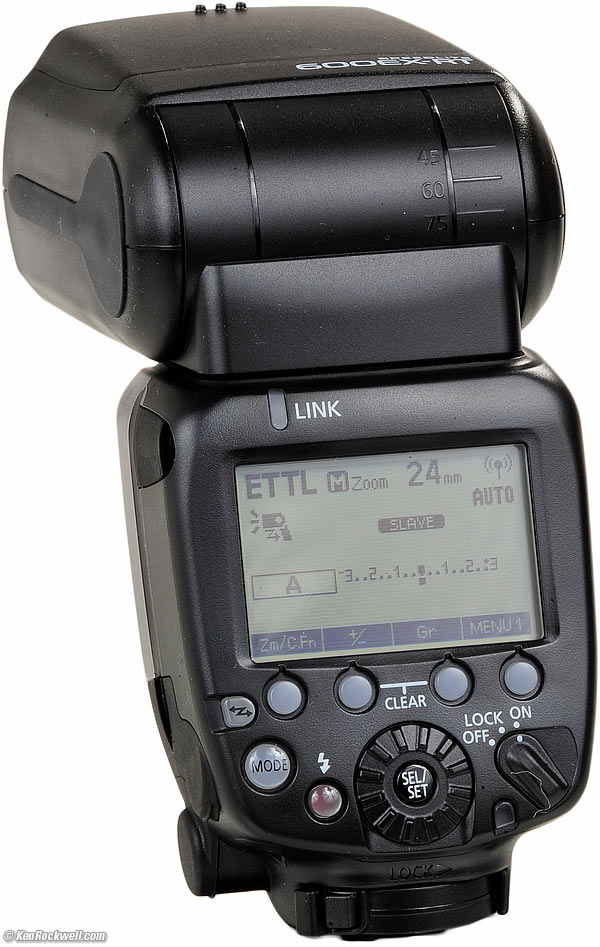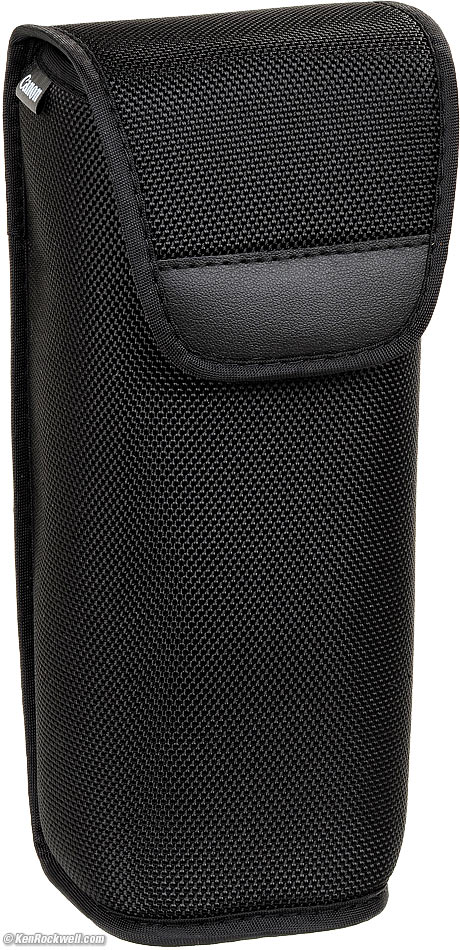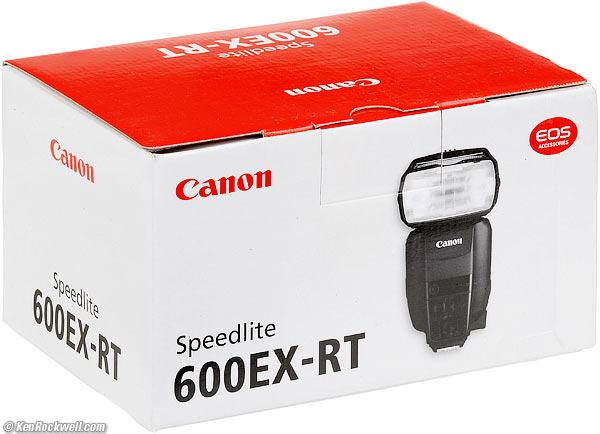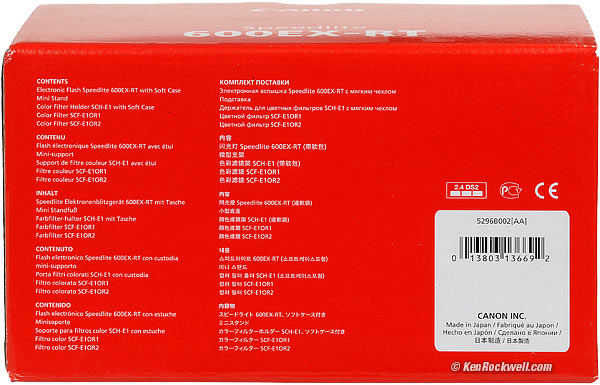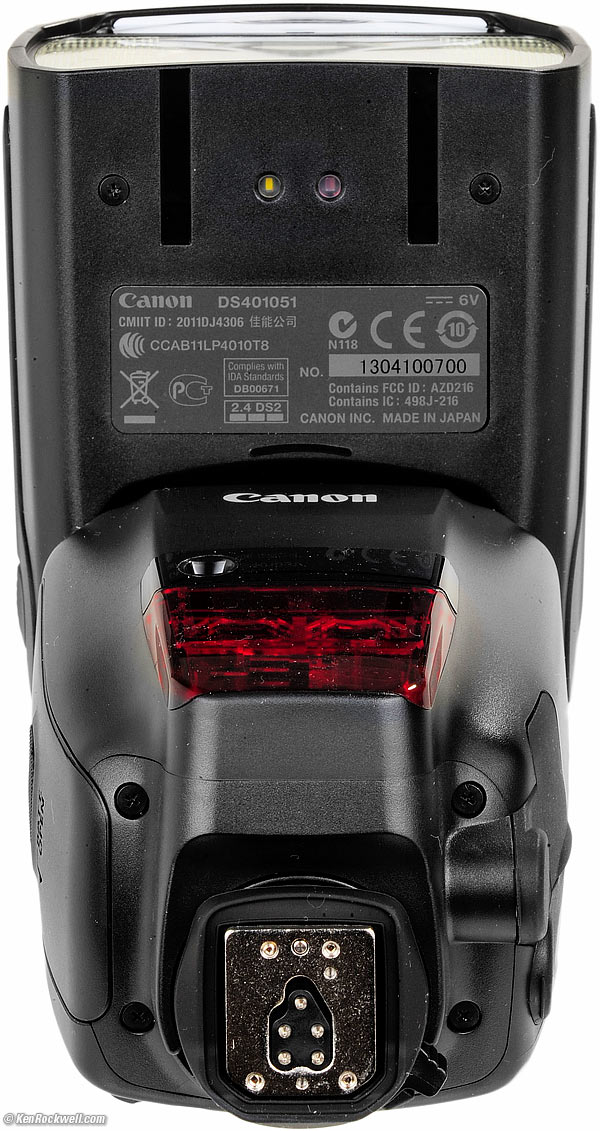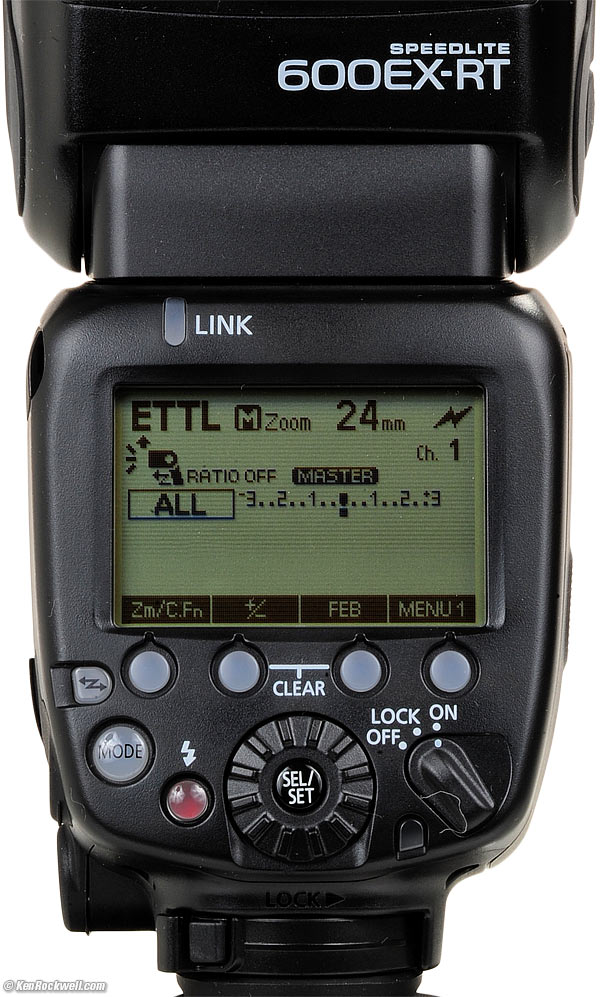Home Donate New Search Gallery Reviews How-To Books Links Workshops About Contact
Canon 600EX-RT
Speedlite Flash (2012-today)
© 2014 KenRockwell.com. All rights reserved.
Intro Compatibility Specs Performance
Compared Usage Recommendations More
Canon 600EX RT (18.7 oz./529g with 4-AA eneloop cells, 2.5 second measured recycle time, measured ISO 100 guide number of 29 meters/95 feet at 35mm, rated guide number 36m/118' at 35mm, 20-200mm zoom head with 14mm wide panel and catchlight card, about $470 new). My biggest source of support is when you use any of these links to approved sources, especially this link directly to it at Adorama (to get the best price you have to add it to your cart) or directly to it at Amazon, when you get anything, regardless of the country in which you live. It helps me keep adding to this free website when you get anything through these links — but I receive nothing for my efforts if you take the chance of buying elsewhere. Thanks for your support! Ken.
February 2014 Canon Reviews Canon Flash Canon Lenses All Reviews
Rear, Canon 600EX RT.
Introduction top
|
I buy only from these approved sources. I can't vouch for ads below. |
Intro Compatibility Specs Performance
Compared Usage Recommendations More
The Canon 600EX-RT is Canon's biggest, fastest, most powerful and most complex flash ever.
The 600EX-RT is the first camera-maker flash with a built-in 2.4 GHz radio trigger system for use by professional wedding photographers. The 600EX-RT system replaces the PocketWizard triggers of the past; all that third-party trigger gear can now be dumped on eBay since Nikon users still need them. Nikon has no radio trigger system, just the older optical trigger system.
Canon also sells a less common 600EX (non-RT) version, which is the same thing without the radio trigger. Both the 600EX and 600EX-RT work with Canon's existing optical trigger system.
It's a bit silly to buy just one 600EX-RT, since the magnificent radio trigger system lives for use with multiple flashes. The pro who buys a 600EX-RT doesn't just buy one or two, he buys at least three or four. You need at least three to light the subject (Key, Fill and Backlight), and another 600EX-RT or the Canon ST-E3-RT transmitter on-camera as the Master to control and trigger it all.
A great thing about this new radio control system is that you can command your entire sea of flashes from the device on your camera. You can run as many as 15 flashes and divide them into 5 groups in the Gr (Group) mode. You get to set each of these 5 groups separately for light level. Shooting amongst other pros? No problem; there are 10,000 different system IDs so no one will pop anyone else's flashes.
Not only can this new radio system fire flashes, it can also fire cameras. You can shoot 15 remote cameras triggered from your master, for a total of 16 synchronous cameras. I doubt you can shoot all these cameras as well as use those channels for flash at the same time, but I haven't tried.
The 600EX-RT has obvious status lights on it to let you see if they are linked and OK, or overheated or have low batteries, all from a distance. You can program how some of this works for your own color preference, for instance, the big rear LCD can be set to glow green, orange or red for different states.
The 600EX-RT is for shooters needing small battery-powered radio-triggered flashes. The pro who uses these has assistants running around holding the other flashes on poles for him. For use in a studio, I use real studio strobes instead, which are easier to use, much more powerful and much less expensive, too.
The 600EX-RT is a silly choice just for use on top of your camera. It's too big and too complex.
Don't let me stop you, but the Canon 430EX II is a much better idea for on-camera use because it's more reasonably sized and has a much more legible rear LCD panel. The 430EX II is just as fast and silent, and more than powerful enough for on-camera use (only a half-stop less maximum power), and half the price. The extra power of the 600EX-RT is needed for pros who shoot them bounced off umbrellas, not for on-camera flash. The 430EX II is smaller, faster-handing and less expensive for people who don't need radio triggers.
Flash exposure is controlled by the camera. Different flashes will give the same results, with the only difference being if they have enough power and if they are ready to shoot fast enough. Don't think that pictures made with the 600EX will be any better than when shot with the 220EX; so long as you have enough light, which with DSLRs and higher ISOs, you always do.
Good
Loads of effortless power. The 600EX RT keeps belting out the power shot after shot without complaint, even if the flash and batteries may be getting hotter than you think.
Super-fast and silent recycling. You can just keep shooting and the 600EX RT keeps blasting out the power with no waiting.
Built-in bounce card.
Bad
Generic dot-matrix LCD crammed with too many things is often difficult to read.
Many buttons have multiple functions as shown on the LCD above them, and that LCD is often difficult to read.
Missing
No "A" mode for use with ancient non-TTL cameras. (Its A mode only works when used with 2007 and newer DSLRs).
Extra Features
Great radio trigger system.
Programmable lights and colors so we can see if the flash is OK and connected, or overheated or not linked, all at a glance from a distance.
Flip-down diffuser panel for 14mm lenses on full-frame or 9mm lenses on APS-C.
Manual power mode.
Wireless optical control.
Wireless radio control.
Comes with a little foot to let it sit on a table.
Repeating stroboscopic flash to 500 Hz.
Rain gasket comes down over hot shoe when locked.
Compatibility top
Intro Compatibility Specs Performance
Compared Usage Recommendations More
It works on all Canon EOS cameras, digital and even Canon's very first 35mm EOS cameras from 1987.
I tried it on my 5D Mark III and my ancient EOS 650 from 1987, and everything that matters like TTL exposure and data communication work great!
Radio Trigger
Canon's 2.4 GHz system is proprietary; it doesn't work with PocketWizard or other brands.
For all the radio trigger functions to work with all five groups, you'll want a camera introduced since 2012, which as of this writing are the 1D X, 5D Mark III, 6D and 70D. Older cameras like the 5D Mark II may only offer three groups.
With all the potential combinations of different cameras and firmware versions, it's impossible to figure out what exactly works on what until actually you try it in person. If in doubt, buy it from an approved source; never take the chance of buying at retail. Try it all at your leisure at home, and if you're not happy, return it for a full cash refund. Especially with firmware updates, there is no way to tell for sure until you try it for yourself; you can't read about it or try it in a retail store — you have to try it yourself with all the rest of your gear.
On 35mm EOS cameras
Everything works great on current 35mm cameras like the EOS 1V.
On the earliest 35mm EOS cameras from the 1980s, TTL and manual exposure and rear sync work great, but the shoe lock, FEL (flash exposure lock) and HSS (high-speed-sync) weren't invented yet, so these features won't magically start working.
Even on my 1987 EOS 650, TTL (through-the-lens) exposure, data communication and the green exposure OK light all work great.
With the 1987 EOS 650, the 600EX RT's computer display cheerfully calculates and displays the flash range as the camera automatically sets the aperture! No problems here with any EOS camera.
On manual-focus 35mm cameras
I didn't try it on any manual focus cameras like the T90, but it should work in TTL on the T90.
For these cameras, you can get used flashes from 25 years ago better dedicated to these cameras for much less money.
Type A or B cameras and Flash Metering Modes 1, 2 and 3
Canon has never told us precisely and exactly which cameras are A or B or which uses Metering Modes 1, 2, or 3, so don't worry about it. See more at Canon.
On older (type B 35mm) cameras, you'll lose some fluff features like FE Lock and High-Speed sync. No worries, everything you need like TTL exposure works great on any EOS camera.
Specifications top
Intro Compatibility Specs Performance
Compared Usage Recommendations More
Power (rated, ISO 100)
Zoom Setting |
GN, Meters |
GN, Feet |
14mm (9mm) |
15 |
49 |
20mm (12mm) |
26 |
85 |
24mm (15mm) |
28 |
92 |
28mm (17mm) |
30 |
100 |
35mm (22mm) |
36 |
118 |
50mm (31mm) |
42 |
138 |
70mm (43mm) |
50 |
164 |
80mm (50mm) |
53 |
174 |
105mm (65mm) |
58 |
190 |
135mm (80mm) |
59 |
194 |
200mm (120mm) |
60 |
197 |
Recycling Time (rated)
5.5 seconds with alkaline cells.
Batteries and Power (rated)
4-AA cells; alkaline, Ni-MH or lithium.
100 full-power flashes with alkaline cells.
Optional CP-E4 external battery pack holds 8-AA cells, $150.
Goes into Standby after about 90 seconds, wakes with a tap of the shutter button.
Zoom Head
20-200mm with 14mm flip-down diffuser.
Smart enough to recognize cropped digital cameras and set itself accordingly.
Bounce
0º to 90º up.
-7º downward.
-180º left to to +90º right horizontal.
AF Illuminator
Yes, infra-red.
The AF illuminator has three emitters: one at the bottom for the center AF sensor, and two above the lower one to light the other AF areas if selected.
Wireless Control
Optical pulse or 2.4 GHz radio transmission.
Works as master or slave.
Optical ("classic")
Rated to 50 feet/15 meters indoors or 30 feet/10 meters outdoors, and the slaves have to face the master controller so they can see it.
4 channels (1, 2, 3 and 4).
3 groups (A, B or C).
Lighting ratios up to ±3 stops in half-stop steps.
Batteries will run for 1,500 flashes if you're using the 600EX-RT as the commander and NOT setting it to flash to expose the image.
Radio (new)
Rated to 100 feet/30 meters, but works much better than rated.
2.405 ~ 2.475 GHz OQPSK with DS-SS.
15 channels with manual or auto select, and even has a spectrum analyzer display built in!
10,000 different wireless IDs.
5 groups (A, B, C, D and E).
Batteries ought to run for 9 hours if you're using the 600EX-RT as the commander only and NOT firing its flash.
Size
3.1 x 5.6 x 4.9 inches, WHD.
79.7 x 142.9 x 124.5 millimeters, WHD.
Weight
18.660 oz. (529.1g) actual measured weight with 4-AA eneloop cells. Alkaline weigh the same, lithium cells weigh less.
15.015 oz. (425.7g) actual measured weight, empty.
Canon specifies 15.0 oz. (425g) empty.
Announced
02 March 2012.
Quality
Flash MADE IN JAPAN.
Plastic stand MADE IN JAPAN.
Case Flash MADE IN CHINA.
Includes
Case, Canon 600EX RT.
Flash
Flash case
Padded nylon velcro-closing case.
The case has a nice velcro attachment on the rear to let it wrap around a camera strap, and the case has a slot inside for the silly stand. There's also a plastic D ring on the other side.
Cute little table stand
The little plastic stand has a shallow 1/4"-20 thread to attach to tripods or light stands, good luck!
Filter System
SCF-E1 filter set, which is a CTO and a fractional CTO gel.
Oddly, no green florescent gel included.
SCH-E1 clear plastic filter holder.
Two more small cases: one for the gels and one for the filter holder.
Optional Accessories
Canon ST-E3-RT transmitter ($290).
CP-E4 external battery pack (8-AA cells, $150).
I don't know if the Yongnuo accessories work or not; when you do this for a living, you can't afford unknown reliability from unknown copy brands.
Price
February 2014: about $470 new or almost as much used.
Box, Canon 600EX RT.
Box back, Canon 600EX RT. bigger.
Performance top
Intro Compatibility Specs Performance
Compared Usage Recommendations More
Power
The 600EX RT is silent and unflappable. It can belt out more power than any other Canon flash and it seems like it isn't even doing anything; it makes no noise and doesn't vibrate as it fires. It seems as if it's flashing at low power, except that it's super bright and the batteries get very warm very fast!
Actual measured output power, ISO 100
Zoom Setting |
GN, Meters |
GN, Feet |
Wide Panel: 14mm (9mm) |
16 |
52 |
20mm (12mm) |
26 |
85 |
35mm (22mm) |
29 |
95 |
50mm (31mm) |
33.5 |
110 |
105mm (65mm) |
43 |
140 |
200mm (125mm) |
46 |
150 |
This is excellent; it's only about 1/2 stop short of its rated power. Most flashes are one stop weaker than rated, so this is excellent performance.
It's got loads of power for fill flash in daylight at f/16 - f/22.
Recycling Times
I measure only 2.5 seconds from a full-power dump to ready light ON with a freshly charged set of eneloop cells.
I measure 3.0 seconds with those cells at about 70% on the ZTS tester.
It charges silently; the inverter runs at a supersonic frequency.
After about 90 seconds it goes into standby, and wakes right up when you tap the shutter and wake up your camera again. The BOLT button will also wake the flash.
If it's been sleeping a while, it wakes right up. After 10 minutes of sleep, it lit the READY light in less than a second, whoo hoo! Lesser flashes like the 270EX II may make us wait 5 seconds or more, which will miss photos.
Filters
The multipiece filter system is retarded. It should use snap-on plastic filters, one for each color, but instead there are a couple of gels and a clear plastic holder for them.
Nikon does this properly in their newest SB-700 and SB-910 flashes, which saves use from having to fumble with Canon's delicate gels and gel holders in the field.
Worse, if you actually use these, some light leaks out the clear sides of the Canon gel holder and can taint the color of the light, making it too blue if you're expecting orange to balance with tungsten.
Velcroed hand-cut gels are easier to use and leak less light. Hopefully the 600EX-RT II will use solid filters.
Ergonomics
For use on-camera
It's easy to use. Slide it on, flip the power lever, and shoot.
The battery cover is sturdy and easy to use, but it's more complex and the cell polarities aren't marked as clearly as they are in the 430EX II.
The power lever works great, except that the white index dot is at an angle, so the lever points to OFF when it's really set to LOCK and it points to LOCK when it's really ON. LOCK means it ignores the other buttons.
The combined ready ("Pilot") light and test button are very good.
If you want to start making adjustments, I find the small jaggy letters on the dot-matrix LCD not as easy to read as on the 430EX-II.
The four menu buttons do different things as labeled on the changing LCD. I can't read the reversed text above the letters, so I can't use this flash easily. Even though the variable markings are tiny and thin, at least the LCD on which they are displayed lights as you use it.
There is no button to light the LCD at night. Instead, the LCD lights anytime you press any button. Sadly, the camera and flash don't communicate this, so pressing the LIGHT button on flash or camera won't light the other.
Instead of a compensation dial or buttons, you have to find and press a button labeled +/- and then turn the dial.
If you set the compensation on-camera, the flash's LCD doesn't update until after you've set it. It immediately updates in your finder and on the camera's top LCD.
The unmarked green "Exposure OK" light between the power lever and jog dial is fine, but not that visible from far away.
Manual zoom is easy, once you remember to turn the dial after hitting the Zm./C.Fn. button.
The MODE button is easy, but there are so many modes that you'll probably have to go-around a couple of times trying to find the one mode you want.
The wireless modes are for professionals who use them every day. It's complex and convoluted, and will take a while for a consumer to figure out.
The good news is once it's set, you can save and recall three banks of settings!
Bottom, Canon 600EX RT. The shoe is silver, but reflecting the black of my studio here.
Zoom Head
It has a 20-200mm range, but don't get too excited. Much as Nikon's silly expanded range, it doesn't do much. As you can see at the power ratings and measurements, the power is not much more concentrated above 105mm. In other words, there isn't really any more concentration of light set to longer than 105mm.
Likewise at the wide end, since I'm not shooting flat walls with wide lenses, I get better illumination without any sort of wide diffuser since walls, floors and ceilings are always closer to me at the edges of my images.
Personally I can do without zoom heads; they don't do much.
Compared top
Intro Compatibility Specs Performance
Compared Usage Recommendations More
Canon 600EX RT
This is Canon's biggest and boldest flash. It's great if you want to use it on camera, but it's really intended for use wirelessly as part of a larger setup. If you only want to use it on camera, the 430EX II makes more sense.
For some silly reason, this is the only current Canon flash with a built in "kicker" bounce card, which we use with bounce flash to keep a highlight in the eyes.
No big deal, with other flashes we've been rubber-banding business cards to our Vivitar 283s since the 1970s.
Canon 430EX II
As covered at the Introduction, the Canon 430EX II is smaller, simpler and faster to set up because its LCD is more legible and there are fewer menus.
The 430EX II has only a half-stop less power and it's half the price, so for on-camera use, the 430EX II is a much smarter choice; we don't need much power on-camera unless we're shooting film.
Canon 220EX (1996-2009)
For general use where I'm not shooting a formal event or portraits all day, I prefer my Canon 220EX. It's what I actually use on-camera and carry with me in my bag; it has more than enough power today with digital SLRs.
Canon 90EX, 270EX and 270EX II
These small flashes have much slower recycling time because they only use 2, not 4, AA cells. I'd forget about them.
Nikon SB-910
The Nikon SB-910 has exactly the same measured power, and the same size and weight as the 600EX-RT.
Sadly for Nikon users, Nikon has no radio trigger system, making the SB-910 and Nikon's flash system a dinosaur — and it costs $100 more.
Usage top
Intro Compatibility Specs Performance
Compared Usage Recommendations More
Back, Canon 600EX RT.
Basic TTL Shooting
The lock lever locks, too. To remove it, you have to push-in the little unlock pin so you can move the lever to the left to unlock the flash from the shoe.
Just slide it on, flip the lock lever to the right, turn it on, and shoot.
It should read "ETTL" or "TTL" on the top top left of the 600EX RT's LCD. If not, press MODE until it does.
You'll see a green"Exposure OK" light between the dial and power lever if your auto exposure was OK.
Everything else is handled automatically. If the flash it too dark or too light, you can change this with your camera's exposure compensation, or press +/- on the rear of the 600EX RT and spin its dial.
The flash range will show on the flash's rear LCD. This can be set to meters or to feet via the flash's CFNs or in a DSLR's Flash menu.
If you're really shooting fast and hard and it can't keep up, it's OK to shoot if you see a green ready light. That means that it's mostly recycled, and you can shoot, but with less maximum power.
If you shoot too hard, which you can't do on-camera with E-TTL but might if you're running at close to full power shooting with light modifiers off-camera, you can overheat the flash and it will start to slow down its recycling time.
High-speed FP Sync
High-Speed Flash (HSS or FP) is easy to set.
Press the SYNC button until you see the BOLT-H icon.
Use Av or Tv mode on your camera.
The flash's LCD will calculate and display your range, which is greatly reduced as you go to higher speeds.
I have no problem shooting at 1/8,000, so long as I'm close enough.
Rear Curtain Sync
Press the SYNC button until you see the >>> icon.
Flash Exposure Lock
For Flash Exposure lock, for instance if your subject is close and off to the side, put the subject in the middle and press FEL on your camera to lock it.
Manual Flash
In manual flash, the correct distance calculated for your ISO and aperture is shown on the LCD.
Test Firing
To test the flash, the camera's meter needs to be off. If the camera's meter is on, pressing the BOLT button won't do anything.
Wireless Flash
If I want remote flash, I use inexpensive professional studio strobes, not these expensive little battery powered gizmos.
Even if you ever figure out how to use wireless strobes, they don't really have the power you want, and even if they did, it's nearly impossible to figure out how to get them positioned as you want them unless you have assistants moving them for you. A $400 set of studio strobes complete with umbrellas and stands is the way to go if you're setting up for portraits.
If you do want to fiddle with wireless strobes, you set everything (like repeating strobe or flash ratios or repeating flash) on the master flash on your camera, and all the slaves follow those commands. You can force any given slave to manual at the slave flash.
Recommendations top
Intro Compatibility Specs Performance
Compared Usage Recommendations More
Get this 600EX RT flash for multiple-flash pro event use where you have assistants running with you.
If you don't want to use one of these flashes as the on-camera transmitter, use the Canon ST-E3-RT transmitter, but it lacks the infrared AF illuminator.
For on-camera use, I prefer the smaller 430EX II, and want to know what I really carry in my bag if I'm not on an assignment that requires a lot of fill flash? I use my tiny but fast and powerful 220EX flash!
With on-camera flash and the high ISOs of DSLRs, we no longer need the power that we used to need when shooting film, so smaller flashes are more than enough on-camera. The 600EX RT is for off-camera use with umbrellas and light modifiers.
With film we have to use the flash as the only source of light indoors, so we need loads of power to bounce it off the ceiling, or to make it light 50 feet away for a head shot of someone at a podium. With digital, the flash now is only for direct fill light, and for that, the 220EX is more than enough.
Use Sanyo eneloop rechargeable batteries. They don't run down when you leave them unused, and are loaded with power for fast recycling even if you haven't used your flash in months.
If you've found all the time, effort and expense I put into researching and sharing all this, my biggest source of support for this free website is when you use any of these links to approved sources, especially this link directly to it at Adorama (to get the best price you have to add it to your cart) or directly to it at Amazon, when you get anything, regardless of the country in which you live. It helps me keep adding to this free website when you get anything through these links — but I receive nothing for my efforts if you take the chance of buying elsewhere.
Thanks for your support!
Ken.
More Information top
Intro Compatibility Specs Performance
Compared Usage Recommendations More
Canon USA's page on the 600EX-RT.
Another review from a pro who shoots them as intended.
Help me help you top
I support my growing family through this website, as crazy as it might seem.
The biggest help is when you use any of these links when you get anything, regardless of the country in which you live. It costs you nothing, and is this site's, and thus my family's, biggest source of support. These places have the best prices and service, which is why I've used them since before this website existed. I recommend them all personally.
If you find this page as helpful as a book you might have had to buy or a workshop you may have had to take, feel free to help me continue helping everyone.
If you've gotten your gear through one of my links or helped otherwise, you're family. It's great people like you who allow me to keep adding to this site full-time. Thanks!
If you haven't helped yet, please do, and consider helping me with a gift of $5.00.
As this page is copyrighted and formally registered, it is unlawful to make copies, especially in the form of printouts for personal use. If you wish to make a printout for personal use, you are granted one-time permission only if you PayPal me $5.00 per printout or part thereof. Thank you!
Thanks for reading!
Mr. & Mrs. Ken Rockwell, Ryan and Katie.
Home Donate New Search Gallery Reviews How-To Books Links Workshops About Contact

